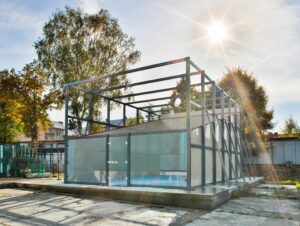
ASB aims to grow Outdoor Squash with New Court Product
Previous Next “Would you like to have such a great squash court in your backyard? The possibilities are now almost limitless!” ASB Tweet ASB recently revealed their latest product: ASB
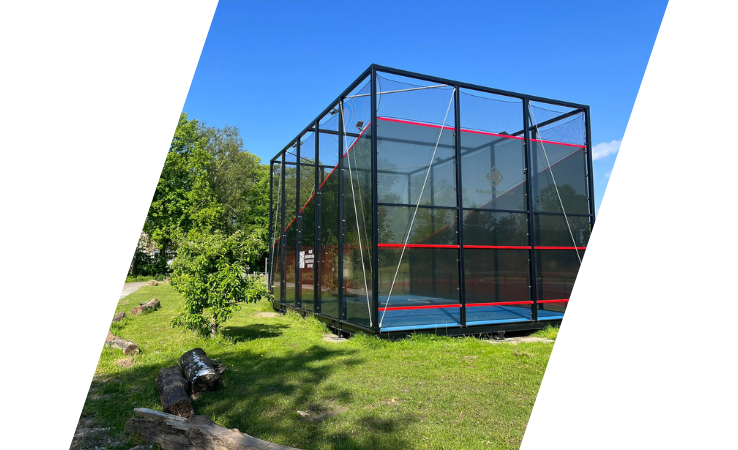
Outdoor squash is not a one size fits all movement. Outdoor squash symbolises accessibility and opportunity to enjoy the game at a grassroots level and have fun playing a fast paced and social game. Each court may not look the same and will adapt to its environment. See below the adaptations you can see around the world today.
89% of squash fans say they would personally enjoy being able to play squash outdoors as well as their indoor squash sessions
83% of squash fans believe having opportunities to play squash outdoors in public settings would help grow membership levels at squash clubs
94% of squash fans believe outdoor courts in public settings would improve the awareness and general knowledge of squash
This page is…
The goal of the PSA Foundation and this page is to be a source of knowledge and inspiration, highlighting all the different projects related to outdoor and mini squash in different parts of the world. We are looking to connect with those considering an outdoor squash project of their own and the supporters of the movement to make outdoor squash a reality.
The COVID-19 pandemic has led to a sharp rise in interest for outdoor squash courts, after a difficult period of restrictions on indoor sports. Squash is internationally known as an indoor sport. Yet, fundamentally there is little reason for it not being played outside as well. Squash is the only racket sport to have not yet taken the game to the outdoors at community level. A wide number of benefits come with taking squash courts outside, such as improved visibility, accessibility and awareness for the sport. There is no singular model that represents outdoor squash. The movement for outdoor squash seeks to break away from a court needing to abide by 1 set of dimensions. It seeks to introduce flexibility on what makes a squash court to increase opportunity to play and get involved.
This is why at the PSA Foundation we have introduced the use of mini courts, Project Beacon and the Outdoor Squash Committee to make strides towards improving and growing the outdoor squash landscape.
In January 2023, the PSA Foundation conducted a survey about the perceptions of Outdoor Squash, receiving over 1,000 responses from 65 different countries around the world. The survey was distributed across various squash related channels and completed by individuals involved in the sport. The results were:
89% of respondents said they would personally enjoy being able to play squash outdoors as well as their indoor squash sessions
83% of respondents said that having opportunities to play squash outdoors in public settings would help grow membership levels at squash clubs
83% of respondents believed outdoor squash would grow general participation levels in squash
94% of respondents believed that outdoor squash courts in public settings would improve the awareness and general knowledge of squash
You can download the results summary here: DOWNLOAD RESULTS SUMMARY
You can download the raw data from the results here: RAW DATA
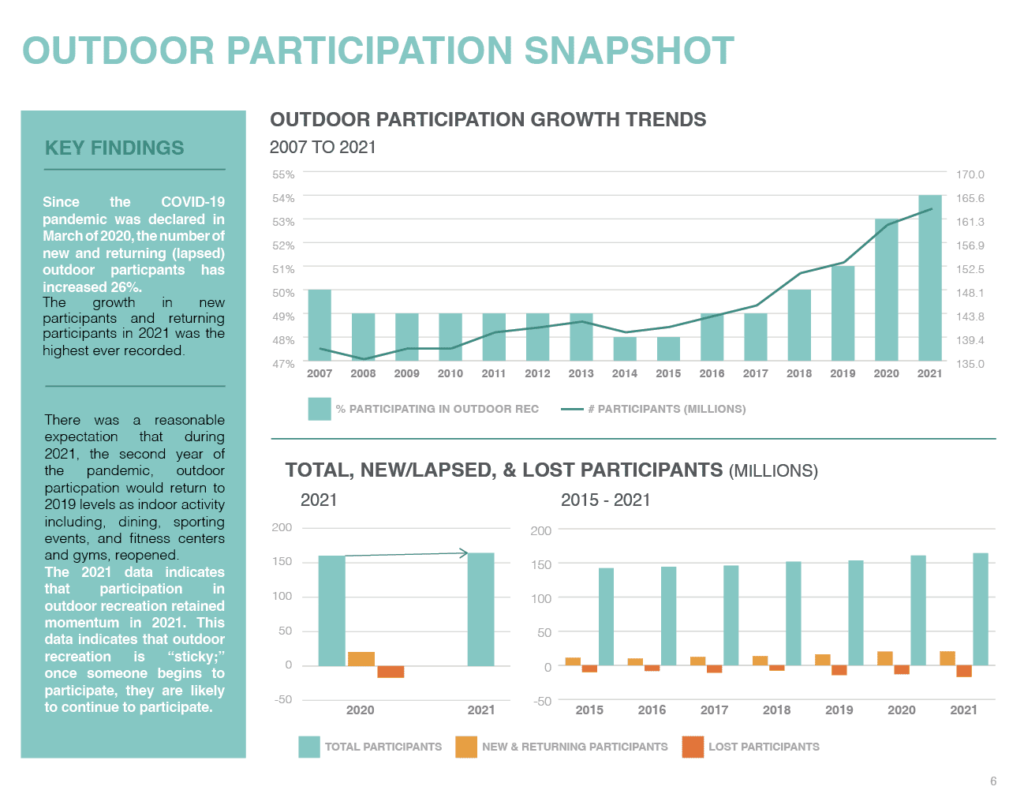
Source: https://outdoorindustry.org/resource/2022-outdoor-participation-trends-report/
The above table suggests a long-term trend of increased participation levels in outdoor recreation, beyond the impact of the COVID-19 pandemic. Further findings suggested that the idea of being physically active outdoors is the leading motivator for outdoor recreation participation. 75% of males and 80% of females indicating this. Entering natural environments, visiting parks and being around nature being the favourite aspects of outdoor recreation. The report also found a disparity in opportunities for outdoor recreation participation by ethnicity for younger populations. In the US, children aged 6-17 years who are white have the highest participation levels of nearly 70%, compared with nearly 47% for African American/black persons. The most visited outdoor venues visited were neighbourhood parks, followed by city parks and then playgrounds. Additionally, despite the increase in overall participation, the percentage of core or regular participants is declining, with the increase in participation being with moderate or casual frequency participants. See linked report above for exact figures.
Current Adaptations Around The World:
The Different Types and Adaptations of Outdoor Squash:
ASB has a proven track record when it comes to glass courts, producing the Show Glass Court used on the PSA World Tour, hosting the best players around the globe. Working for a variety of private clients world wide, ASB understand how to innovate and create bespoke products of court.
Among the very first of outdoor courts, the Public Squash court in New York City’s Hamilton Fish Park was opened in April 2018 and built by ASB. The court produced was a high spec design that played as well as any indoor court. Very few, if any, publicly accessible squash courts like it existed at the time. This court was a significant first step for the outdoor court movement. Find out more about the ASB Community Squash Court here: https://asbsquash.com/products/squash-court-asb-communitysquashcourt/
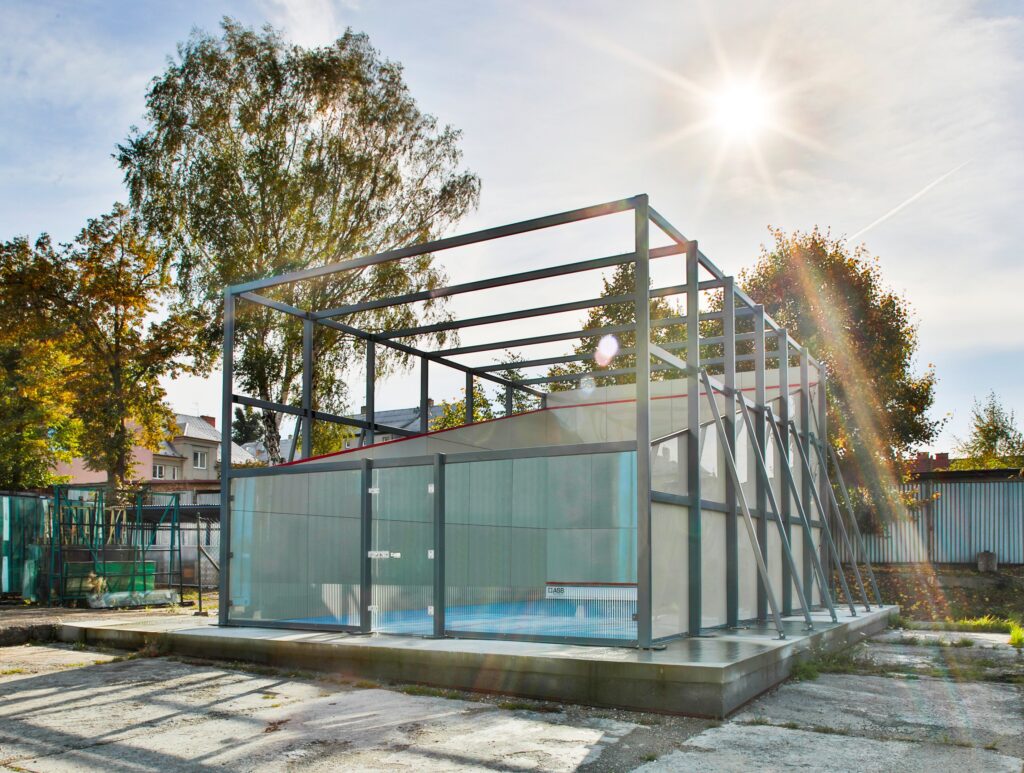
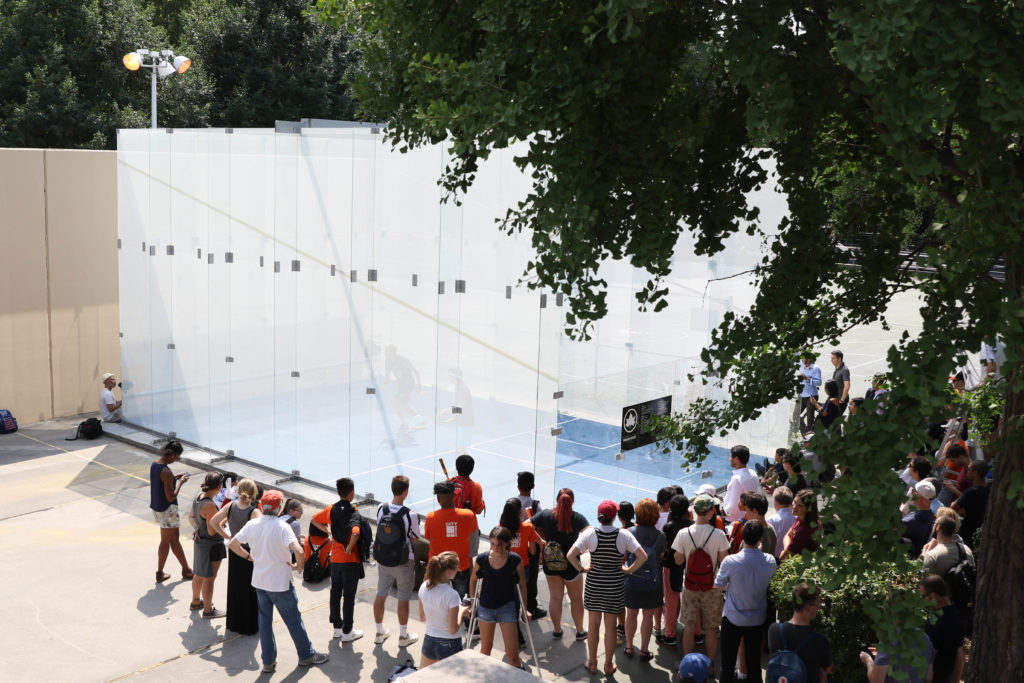
TPoint Squash Courts
Modular squash courts that combine with in advancements technology. These courts offer eye catching LED light patterns around the court that are customisable using the inbuilt control pad. From there you can also control the court’s air conditioning, speakers, camera for live streaming, electronic shade, timer display functions, visible score panel and more! The TPoint squash courts offers you true premium quality facilities on the spectrum of outdoor courts.
Find out more about TPoint courts here: https://asbsquash.com/products/squash-court-tpoint/
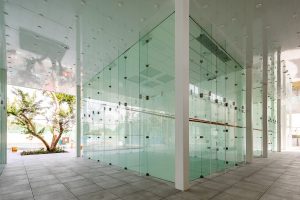

Constructed from a steel frame, tempered glass walls, wooden floor beams and composite floor panels, this exciting innovation by Fresh Squash Courts represents a great opportunity to take the sport outside. The Court was designed in the hope of recreating the dynamics of indoor play out in the open air and at approximately €60,000, excluding taxes, transport, and assembly, the court presents a more accessible price for developers everywhere.
In the Spring of 2025, one of these courts will be placed in a central public park in Chicago as part of Project Beacon which you can read more about here: https://psafoundation.com/beacon/
To find out more about the Fresh Squash Court visit: https://freshsquashcourts.com/#court
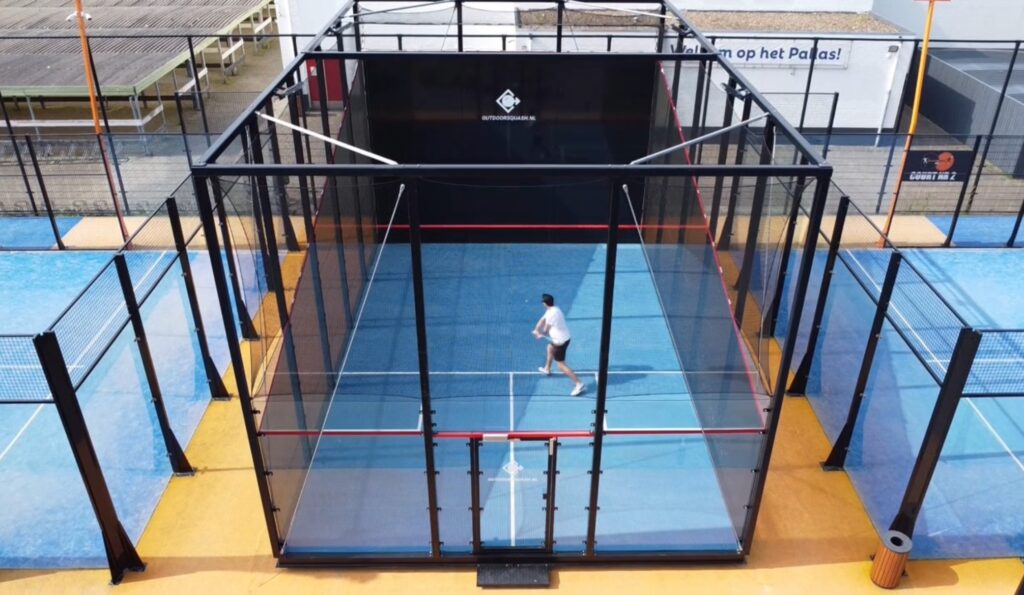
A court that caters to multiple different sports is a facility that offers better value for money for any organisation. Such a court also better guarantees the sustainability of that space. It can be natural for participation levels to dip and rise over time for different sports in different locations. If a squash court is used for multiple sports going through their own lifecycles of participation, between those different sports there would be sufficient demand for that space over time to reduce the risk of losing that facility or it falling into disrepair.
Here, ASB shows you some innovative ways that a squash court can be adapted to cater to multiple different sports. Such a facility also becomes a lot more affordable if the cost is spread across multiple sports & organisations. While these illustrations aren’t of an outdoor court, you can see squash, walleyball, soccer, basketball and table tennis on offer here. Find out more about the ASB MultiSport Court here: https://asbsquash.com/products/squash-court-asb-multisportcourt/
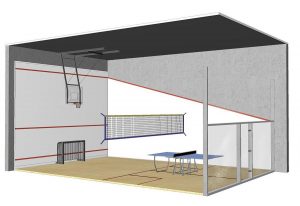
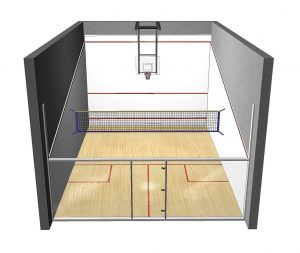
Squash Plus’s lower-cost court with a steel and polycarbonate canopy which provides enough protection to ensure use in a variety of climates and weather conditions. The court benefits from natural light throughout the day, then makes use of LED lights during the night. The court uses a weather proof non-slip glass floor, the whole build offering low construction costs due to the rise in price for alternatives such as brick and mortar. They are continually refining the specification trialling numerous materials at our R&D court in Spain.
A flexible design, the court can be a temporary fixture, relocated or leased to different sites. It can also fit into modular configurations of multiple courts to create social community orientated spaces. Find out more about the Squash Plus court on their website here: https://www.squashplus.us/
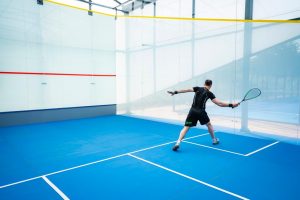
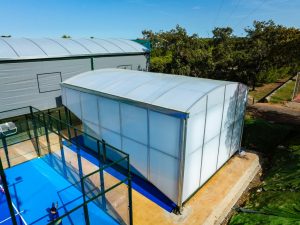
Short Wall Squash
A very simple design, made entirely out of concrete, 4 courts back to back to minimise cost and maximise space. A common barrier to courts in public spaces is the risk of a hidden space being used for anti-social behaviour. In this instance, the side and back walls are only 1.2 metres high. Research suggested that few balls hit above this height on the side and back walls and so was a worthy sacrifice for allowing constant coaching and surveillance of inside the court. For younger ages and beginners, the lower side walls are even less of an issue.
Squash Para Todos are a registered charity from El Salvador that seek to use the vehicles of squash and education to improve quality of life for local underserved children. These 4 courts are used as the entry point for an introduction to squash. After a year or two as the more committed and talented juniors emerge, they are graduated to the Squash Para Todos indoor facility and ASB made courts. Find out more about them here: http://www.squashparatodos.org/growing-backwards/

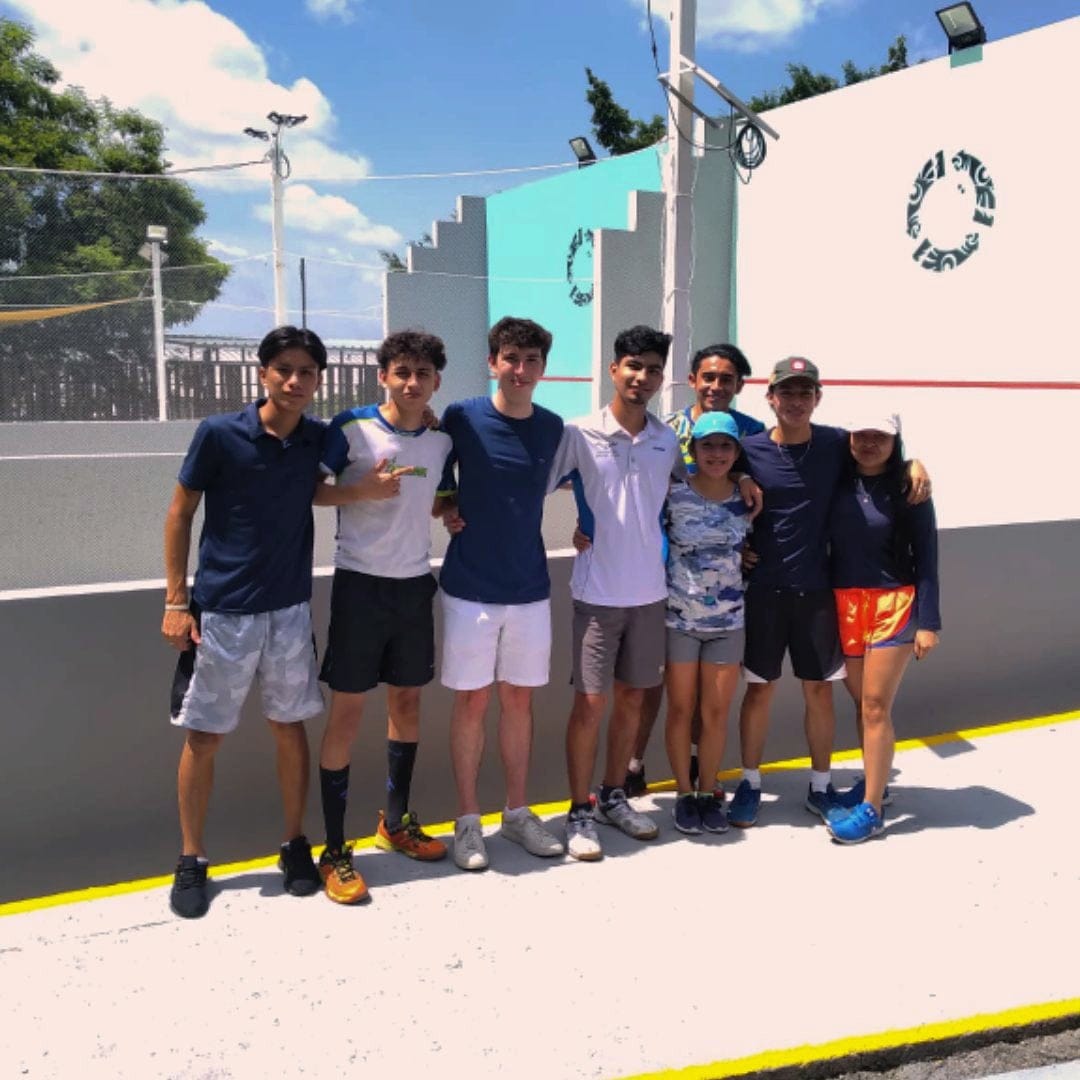
A regulation-size singles squash court with three seamless steel walls, a glass back wall, and a wood panel floor suspended on a steel framework, set in an industrial company backyard.
The Maspeth Squash court is the first and only outdoor, open-air steel-walled squash court anywhere, ever. The “steel court” or “the field of dreams in Queens” is a tourist destination for squash players from around the world and is the only court used for the $21K Intsel Steel Pro Invitational Tournament. The Maspeth Squash court recently won Metal Architecture’s 2022 Design Award for “Smooth Metal Wall Panels.” It is well-regarded as “functional art” with a great playing experience.
This outdoor squash court was conceived in 2019 and opened for play in June 2020. It was originally created as an art project that Jeff Anschlowar, President of Maspeth Welding, and Robert Gibralter, co-creator, could play on themselves. From their very first strokes, Jeff and Robert knew the court’s performance and experience were proof of concept: that steel-walled courts have the potential to help transform squash from an indoors-only, exclusive sport into an accessible outdoor inclusive sport.
Maspeth Squash was created to develop beautiful outdoor courts never before imagined. Now Jeff and Robert, together with Sari Chang of Jacobschang Architecture, provide strategic and creative thinking for siting courts, produce schematics that inspire and galvanize support, and integrate with local resources to build sustainable outdoor squash courts. Maspeth Squash/Jacobschang is the team working on The PSA Foundation’s Beacon Project.
Find out more here: MaspethSquash.com
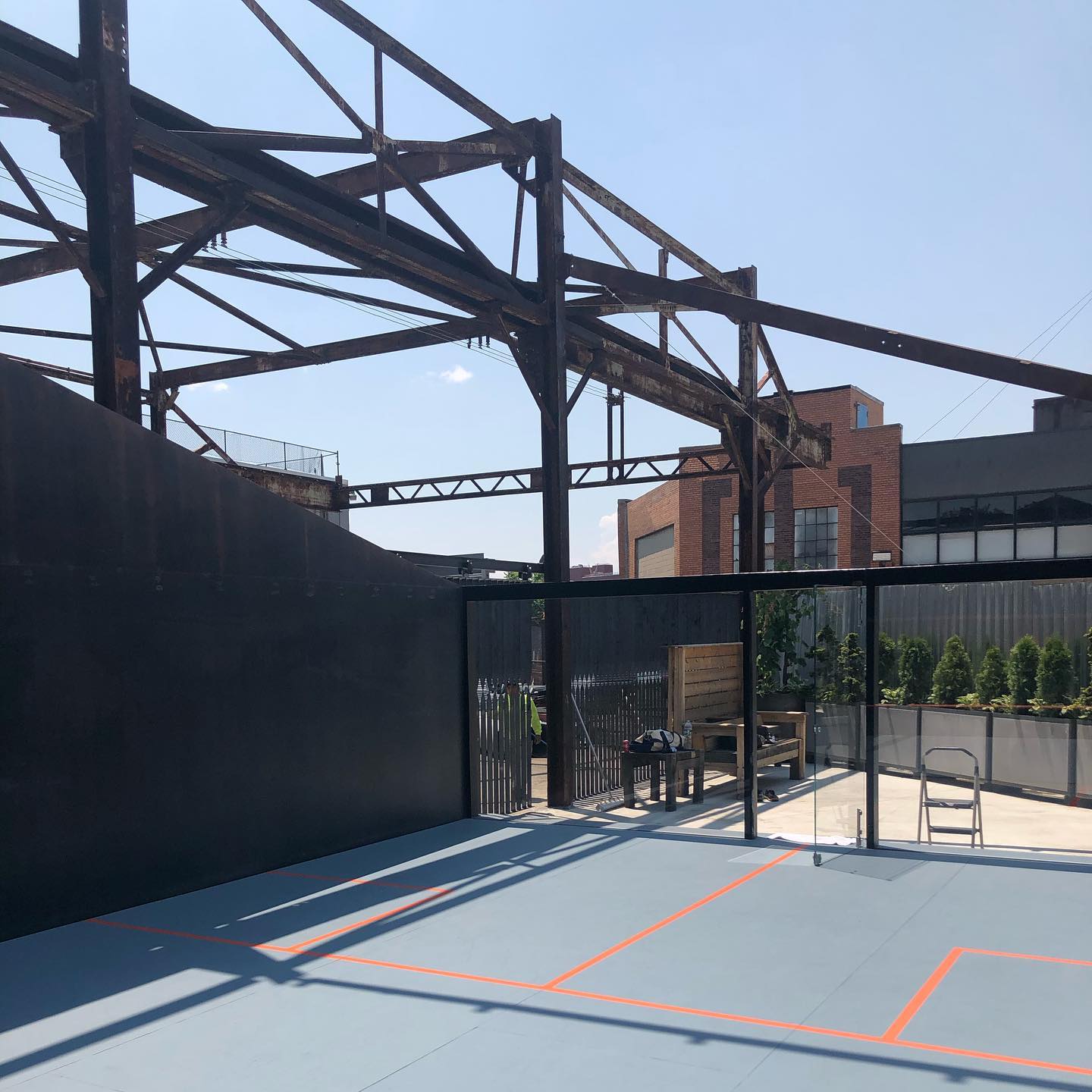
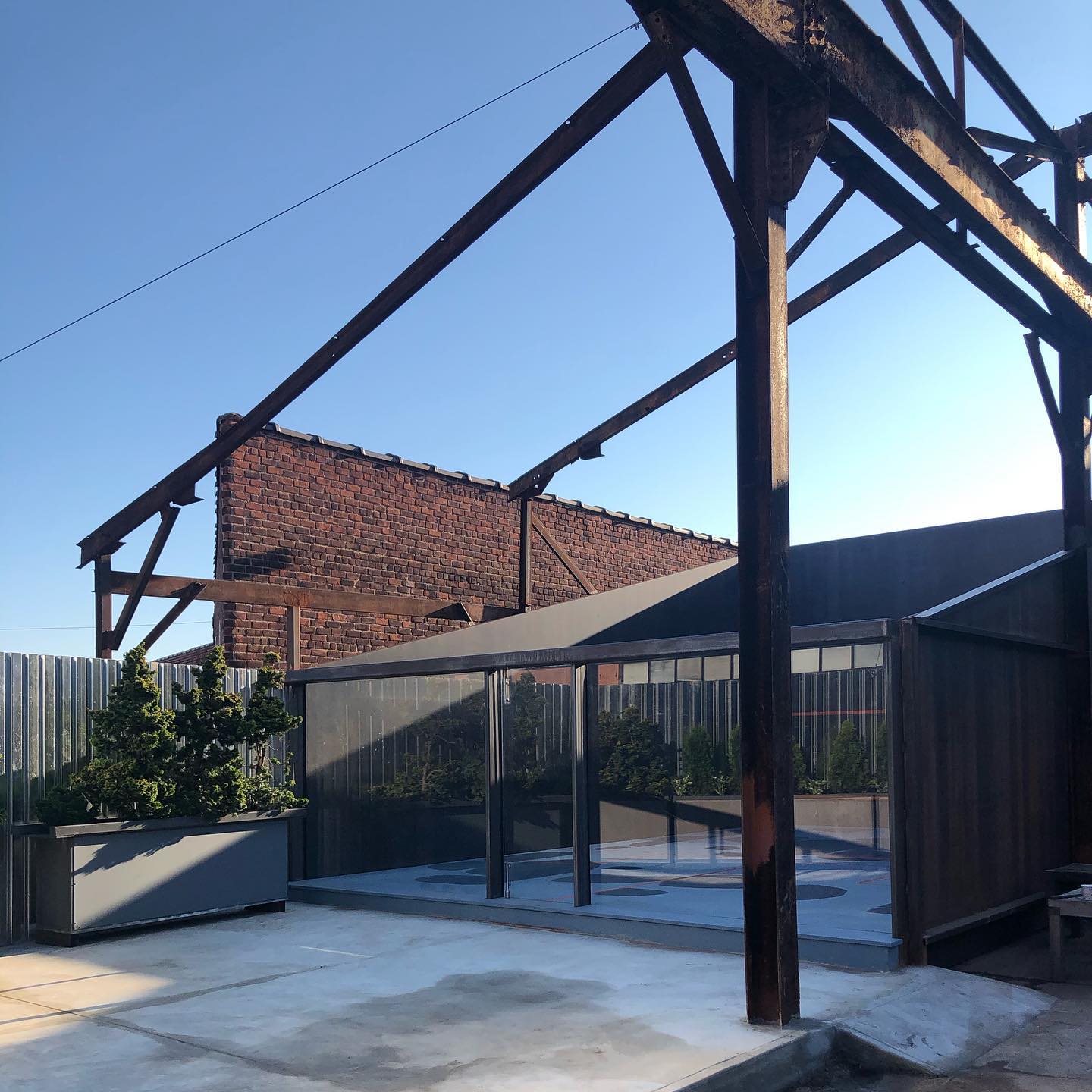
Since the COVID-19 pandemic there has been a spike in adaptations for mini squash courts. While it would be great to see full sized outdoor squash courts in public spaces world wide, this represents a much more affordable and accessible means of participation, especially for younger age groups. These can be made out of a variety of materials and have taken many forms so far:
Perspex Mini Squash Court by Melior Sports
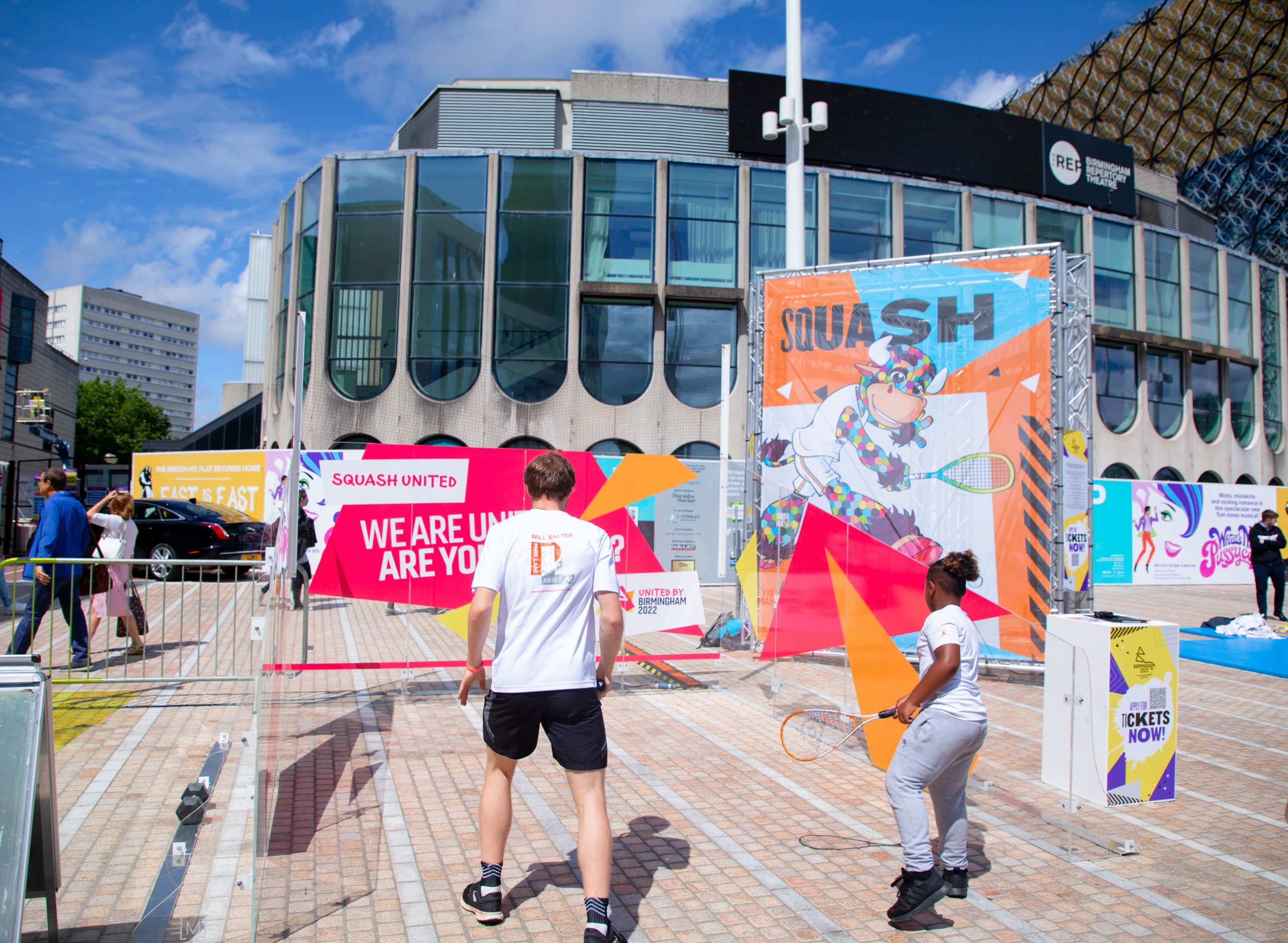

New to 2021 and made of a Perspex material, these courts were launched at the Birmingham 2022 Commonwealth Games roadshow events, showcasing all the sports involved throughout the Midlands communities, England. They are great for catching the eye of passer-by’s and very easy to play on with the right junior ball and racket. Find out more about these courts here: https://www.meliorsports.com/mini-courts
Inflatable Squash Court
Initiated by the Fédération Française de Squash, this inflatable court brings all the benefits of portability. The capability of packing it away in the boot of a car offers another means of taking squash to local communities, promoting the sport and signposting passer-by’s to where their nearest courts are.
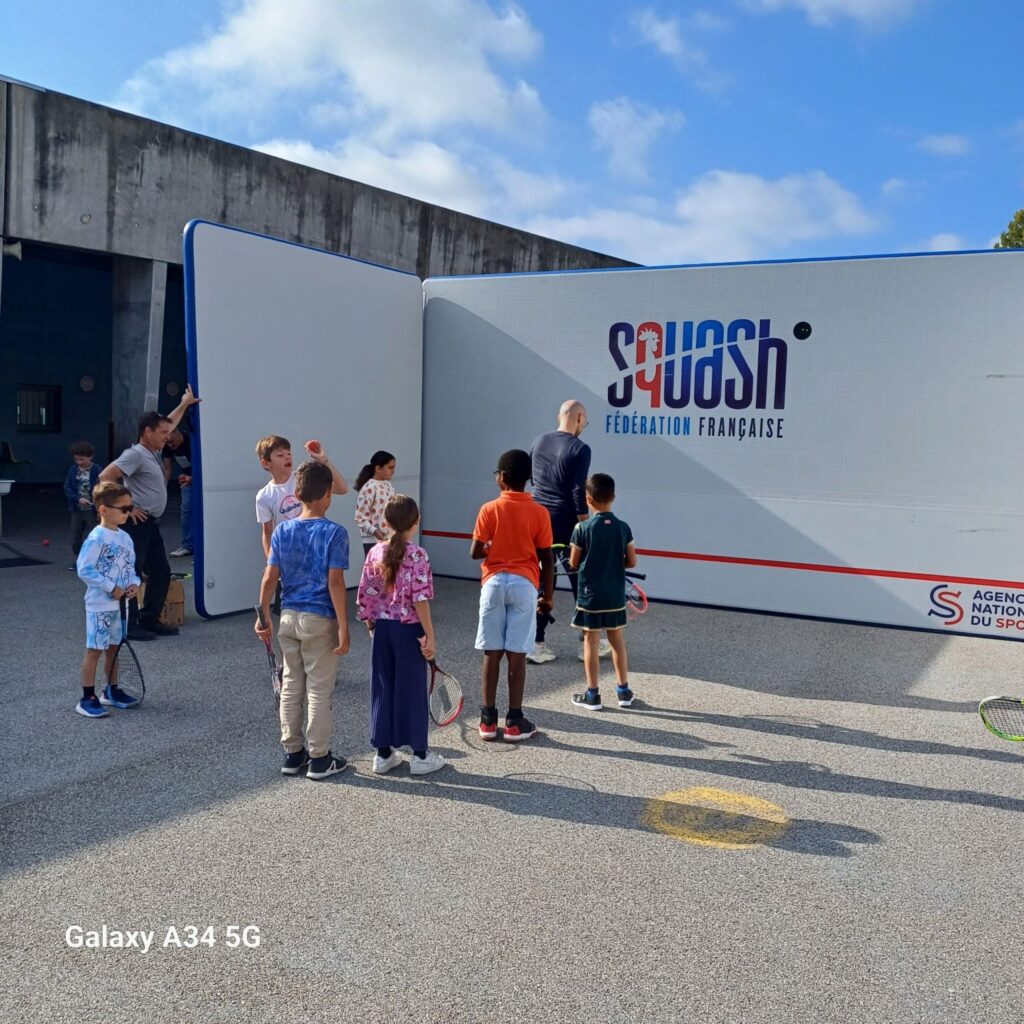
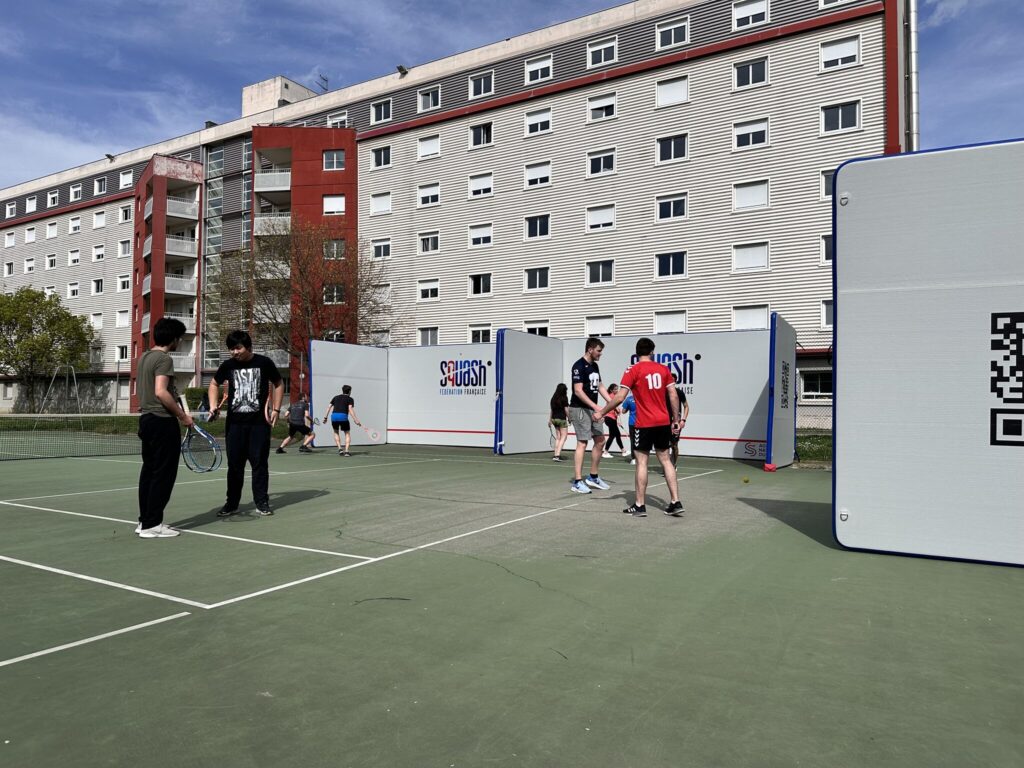
In theme with the mini squash courts, these types of adaptations of available spaces are great at improving the accessibility and opportunities to make that first leap into squash. Mass participation sports at a grass roots level can easily make use of multi-purpose facilities and spaces. The more squash can blend and work other sports, the more accessible and integrated it becomes alongside other mainstream sports.
In badminton you can cheaply buy a pop-up outdoor net to stick in the ground, table tennis has nets that attach to dining tables and official playing tables are relatively affordable, and public tennis courts can frequently be seen in parks. These are all great entry levels to their respective sports, so what is the point of entry for grass roots squash?

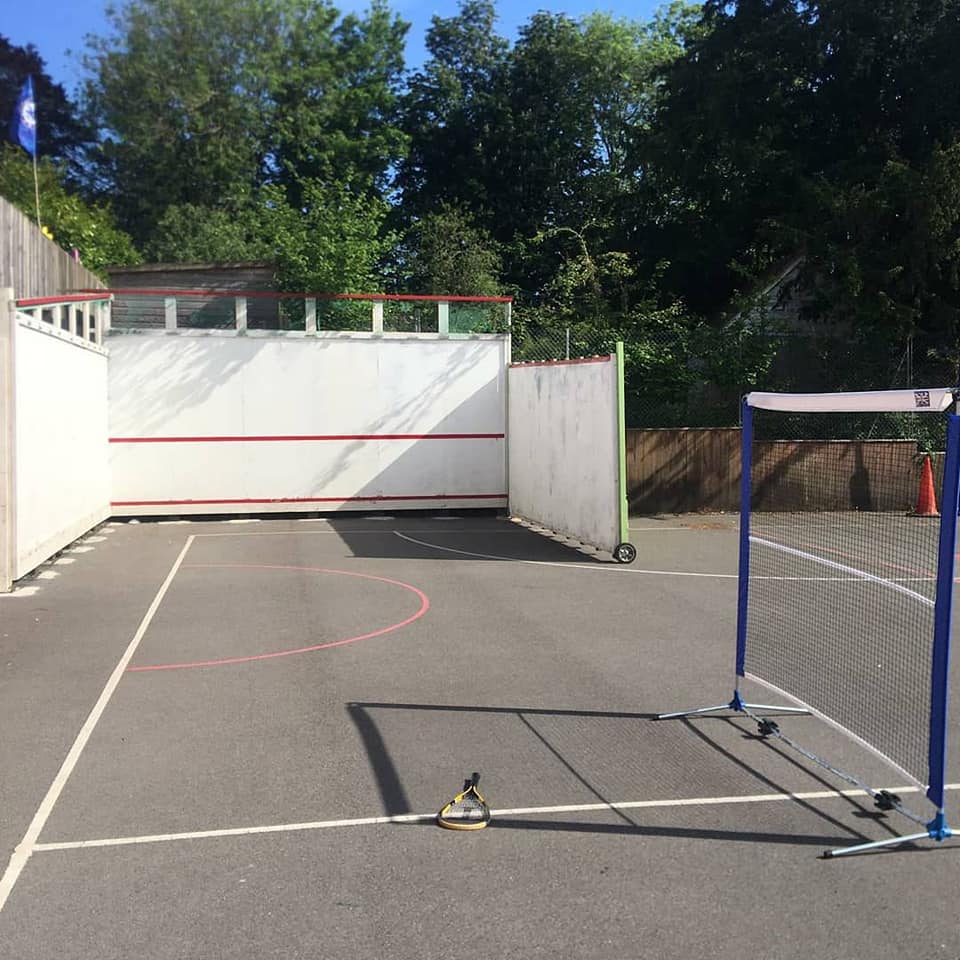
Collapsible Squash Court
Constructed by the Swedish Squash Federation and carpenter Christian Borgwall, this wooden court compresses against a gymnasium wall and folds out to full size in 5 minutes. A perfect example of how hybrid sport spaces can maximise the accessibility and visibility of our sport. You can find out more about this innovation here at Squash Facilities Network: https://www.squashfacilities.com/post/world-s-first-collapsible-court-to-open-up-access-to-squash-in-stockholm
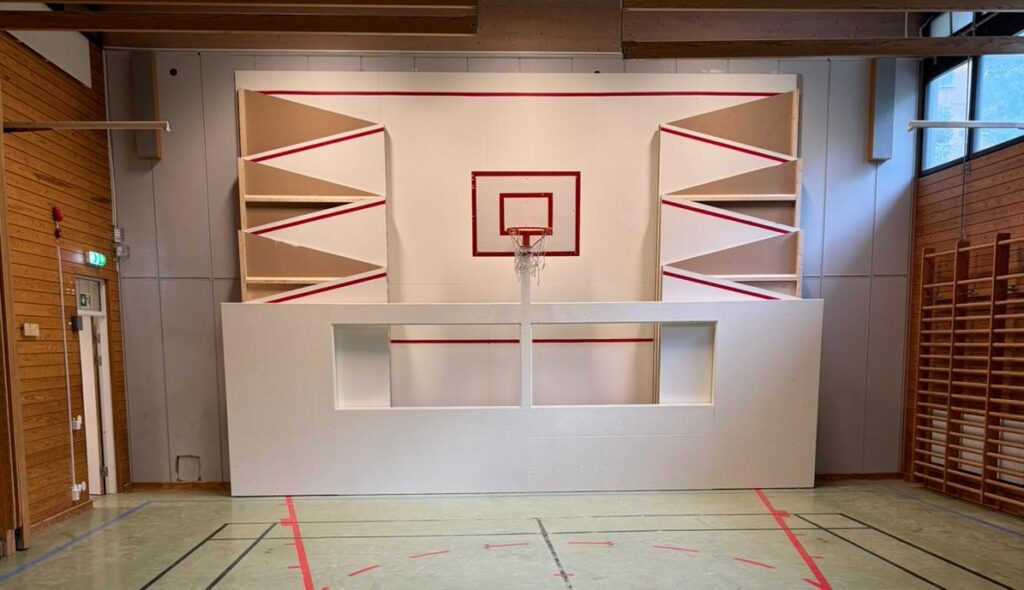
Any successful mass-participation sport has accessible and affordable entry points to play. In football it’s a cheap ball and ‘jumpers for goalposts’. In baseball its 2 people with a bat and ball. In England there are 1,946 free to use public tennis courts. In the vast majority of communities the entry point for squash resides in high spec facilities on a court with perfect dimensions and high booking fees. The current infrastructure for squash leaves the game significantly disadvantaged at capturing new faces who could much more easily try other sports.
In 2024, these playground courts in Birmingham, constructed by Play Innovation and England Squash tackle many of these challenges. Utilising unofficial dimensions, this outdoor squash innovation boosts the participation of our sport in communities with an absence of accessible facilities. https://playinnovation.co.uk/


The Different Types and Adaptations of Outdoor Squash:
ASB has a proven track record when it comes to glass courts, producing the Show Glass Court used on the PSA World Tour, hosting the best players around the globe. Working for a variety of private clients world wide, ASB understand how to innovate and create bespoke products of court.
Among the very first of outdoor courts, the Public Squash court in New York City’s Hamilton Fish Park was opened in April 2018 and built by ASB. The court produced was a high spec design that played as well as any indoor court. Very few, if any, publicly accessible squash courts like it existed at the time. This court was a significant first step for the outdoor court movement. Find out more about the ASB Community Squash Court here: https://asbsquash.com/products/squash-court-asb-communitysquashcourt/


TPoint Squash Courts
Modular squash courts that combine with in advancements technology. These courts offer eye catching LED light patterns around the court that are customisable using the inbuilt control pad. From there you can also control the court’s air conditioning, speakers, camera for live streaming, electronic shade, timer display functions, visible score panel and more! The TPoint squash courts offers you true premium quality facilities on the spectrum of outdoor courts.
Find out more about TPoint courts here: https://asbsquash.com/products/squash-court-tpoint/


Constructed from a steel frame, tempered glass walls, wooden floor beams and composite floor panels, this exciting innovation by Fresh Squash Courts represents a great opportunity to take the sport outside. The Court was designed in the hope of recreating the dynamics of indoor play out in the open air and at approximately €60,000, excluding taxes, transport, and assembly, the court presents a more accessible price for developers everywhere.
In the Spring of 2025, one of these courts will be placed in a central public park in Chicago as part of Project Beacon which you can read more about here: https://psafoundation.com/beacon/
To find out more about the Fresh Squash Court visit: https://freshsquashcourts.com/#court

A court that caters to multiple different sports is a facility that offers better value for money for any organisation. Such a court also better guarantees the sustainability of that space. It can be natural for participation levels to dip and rise over time for different sports in different locations. If a squash court is used for multiple sports going through their own lifecycles of participation, between those different sports there would be sufficient demand for that space over time to reduce the risk of losing that facility or it falling into disrepair.
Here, ASB shows you some innovative ways that a squash court can be adapted to cater to multiple different sports. Such a facility also becomes a lot more affordable if the cost is spread across multiple sports & organisations. While these illustrations aren’t of an outdoor court, you can see squash, walleyball, soccer, basketball and table tennis on offer here. Find out more about the ASB MultiSport Court here: https://asbsquash.com/products/squash-court-asb-multisportcourt/


Squash Plus’s lower-cost court with a steel and polycarbonate canopy which provides enough protection to ensure use in a variety of climates and weather conditions. The court benefits from natural light throughout the day, then makes use of LED lights during the night. The court uses a weather proof non-slip glass floor, the whole build offering low construction costs due to the rise in price for alternatives such as brick and mortar. They are continually refining the specification trialling numerous materials at our R&D court in Spain.
A flexible design, the court can be a temporary fixture, relocated or leased to different sites. It can also fit into modular configurations of multiple courts to create social community orientated spaces. Find out more about the Squash Plus court on their website here: https://www.squashplus.us/


Short Wall Squash
A very simple design, made entirely out of concrete, 4 courts back to back to minimise cost and maximise space. A common barrier to courts in public spaces is the risk of a hidden space being used for anti-social behaviour. In this instance, the side and back walls are only 1.2 metres high. Research suggested that few balls hit above this height on the side and back walls and so was a worthy sacrifice for allowing constant coaching and surveillance of inside the court. For younger ages and beginners, the lower side walls are even less of an issue.
Squash Para Todos are a registered charity from El Salvador that seek to use the vehicles of squash and education to improve quality of life for local underserved children. These 4 courts are used as the entry point for an introduction to squash. After a year or two as the more committed and talented juniors emerge, they are graduated to the Squash Para Todos indoor facility and ASB made courts. Find out more about them here: http://www.squashparatodos.org/growing-backwards/


A regulation-size singles squash court with three seamless steel walls, a glass back wall, and a wood panel floor suspended on a steel framework, set in an industrial company backyard.
The Maspeth Squash court is the first and only outdoor, open-air steel-walled squash court anywhere, ever. The “steel court” or “the field of dreams in Queens” is a tourist destination for squash players from around the world and is the only court used for the $21K Intsel Steel Pro Invitational Tournament. The Maspeth Squash court recently won Metal Architecture’s 2022 Design Award for “Smooth Metal Wall Panels.” It is well-regarded as “functional art” with a great playing experience.
This outdoor squash court was conceived in 2019 and opened for play in June 2020. It was originally created as an art project that Jeff Anschlowar, President of Maspeth Welding, and Robert Gibralter, co-creator, could play on themselves. From their very first strokes, Jeff and Robert knew the court’s performance and experience were proof of concept: that steel-walled courts have the potential to help transform squash from an indoors-only, exclusive sport into an accessible outdoor inclusive sport.
Maspeth Squash was created to develop beautiful outdoor courts never before imagined. Now Jeff and Robert, together with Sari Chang of Jacobschang Architecture, provide strategic and creative thinking for siting courts, produce schematics that inspire and galvanize support, and integrate with local resources to build sustainable outdoor squash courts. Maspeth Squash/Jacobschang is the team working on The PSA Foundation’s Beacon Project.
Find out more here: MaspethSquash.com


Since the COVID-19 pandemic there has been a spike in adaptations for mini squash courts. While it would be great to see full sized outdoor squash courts in public spaces world wide, this represents a much more affordable and accessible means of participation, especially for younger age groups. These can be made out of a variety of materials and have taken many forms so far:
Perspex Mini Squash Court by Melior Sports

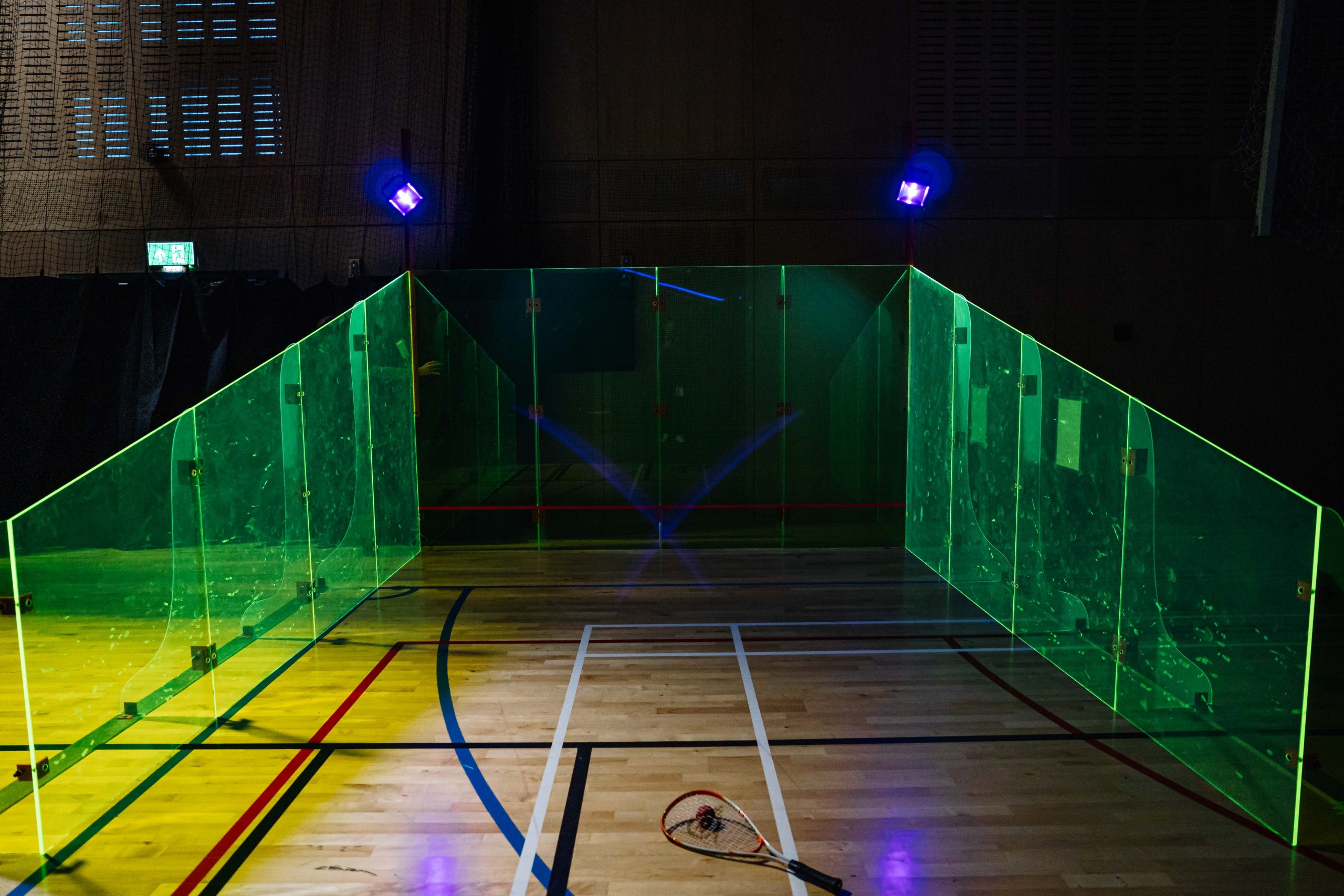
New to 2021 and made of a Perspex material, these courts were launched at the Birmingham 2022 Commonwealth Games roadshow events, showcasing all the sports involved throughout the Midlands communities, England. They are great for catching the eye of passer-by’s and very easy to play on with the right junior ball and racket. Find out more about these courts here: https://www.meliorsports.com/mini-courts
Inflatable Squash Court
Initiated by the Fédération Française de Squash, this inflatable court brings all the benefits of portability. The capability of packing it away in the boot of a car offers another means of taking squash to local communities, promoting the sport and signposting passer-by’s to where their nearest courts are. https://www.ffsquash.com/fr/clubs-et-associations/equipements/les-types-de-courts/le-court-exterieur.html
In theme with the mini squash courts, these types of adaptations of available spaces are great at improving the accessibility and opportunities to make that first leap into squash. Mass participation sports at a grass roots level can easily make use of multi-purpose facilities and spaces. The more squash can blend and work other sports, the more accessible and integrated it becomes alongside other mainstream sports.
In badminton you can cheaply buy a pop-up outdoor net to stick in the ground, table tennis has nets that attach to dining tables and official playing tables are relatively affordable, and public tennis courts can frequently be seen in parks. These are all great entry levels to their respective sports, so what is the point of entry for grass roots squash?


Collapsible Squash Court
Constructed by the Swedish Squash Federation and carpenter Christian Borgwall, this wooden court compresses against a gymnasium wall and folds out to full size in 5 minutes. A perfect example of how hybrid sport spaces can maximise the accessibility and visibility of our sport. You can find out more about this innovation here at Squash Facilities Network: https://www.squashfacilities.com/post/world-s-first-collapsible-court-to-open-up-access-to-squash-in-stockholm
Any successful mass-participation sport has accessible and affordable entry points to play. In football it’s a cheap ball and ‘jumpers for goalposts’. In baseball its 2 people with a bat and ball. In England there are 1,946 free to use public tennis courts. In the vast majority of communities the entry point for squash resides in high spec facilities on a court with perfect dimensions and high booking fees. The current infrastructure for squash leaves the game significantly disadvantaged at capturing new faces who could much more easily try other sports.
In 2024, these playground courts in Birmingham, constructed by Play Innovation and England Squash tackle many of these challenges. Utilising unofficial dimensions, this outdoor squash innovation boosts the participation of our sport in communities with an absence of accessible facilities. https://playinnovation.co.uk/
A Key Learning
A squash facility in a public setting, whether it’s in a local park or school playground is not likely to sustain participation on its own, but coupled with using local clubs and coaches to drive engagement, we can further create a sustainable outdoor squash model to help grow the sport we all love from the grassroots up.
The PSA Foundation Outdoor Squash Committee
The PSA Foundation advocates for outdoor squash as a concept that has the potential to vastly improve the accessibility, visibility and inclusivity of the sport. The Committee is formed of a selection of PSA Foundation trustees and other key individuals experienced in outdoor community squash. We believe that by a process of collaboration and communication, we can help facilitate the growth of the outdoor squash movement.
Purpose of the Committee
To improve the accessibility and inclusivity of the sport, by visibly taking squash to the community through the development and growth of outdoor squash.
Mission: To innovate and revitalize the game of squash as open, accessible, and outside
We will do this by:
If you would like to reach out to us about any other queries or questions, please contact us at foundation@psaworldtour.com

Previous Next “Would you like to have such a great squash court in your backyard? The possibilities are now almost limitless!” ASB Tweet ASB recently revealed their latest product: ASB
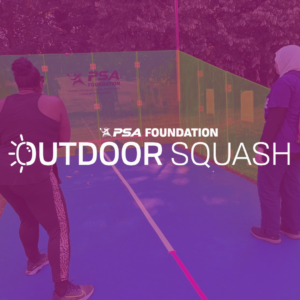
Previous Next “Outdoor squash is a revelation, it gets the game out of private clubs and into the public eye and above all it provides a great environment to play
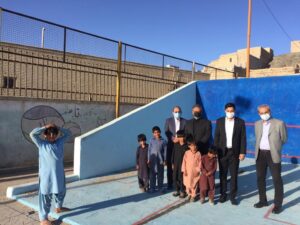
PSA Foundation aims to grow the presence of Squash across the globe with a pledge to improve the game’s accessibility, capturing an engaged worldwide fanbase and leveraging the pro tour
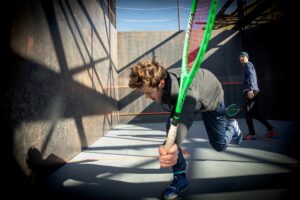
https://psafoundation.com/wp-content/uploads/2022/12/Steel-City-Web.mp4 Photo/Video Credit: Alfredo Ramirez, Restrung Magazine “Outdoor squash is a revelation, it gets the game out of private clubs and into the public eye and above all it provides
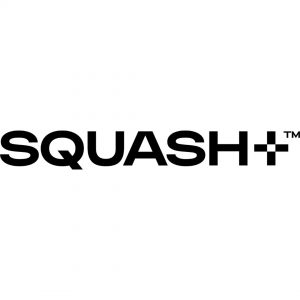
Squash Plus is on a mission to to raise the profile of the game and to make the sport more accessible to all, with a particular focus on younger ages.

A new innovative outdoor squash court has been officially unveiled today at King Solomon International Business School in Birmingham which aims to build on the excitement of the Birmingham 2022
Professional Squash Association Foundation is a UK registered Charity; Number 1172490
& a 501c3 registered charity in the USA
Copyright 2024 by PSA Foundation